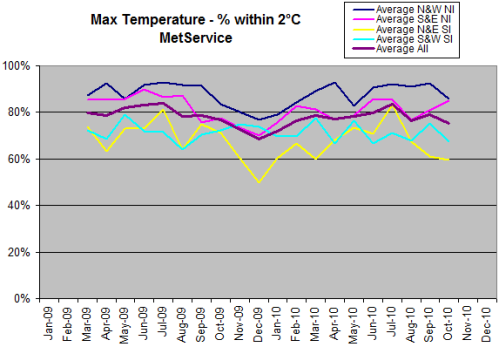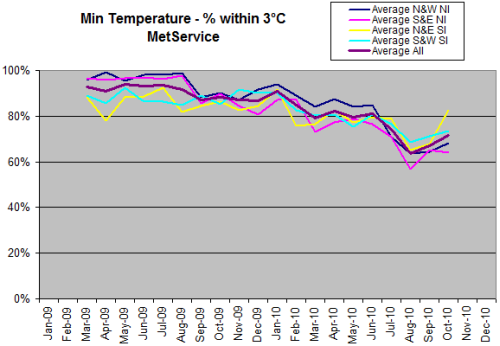This blog post is the second in a three-part series discussing verification of MetService forecasts. Here, we present the method used for verifying maximum and minimum temperature in city forecasts, along with some recent examples.
Verification Scheme
Four times daily (around 11:15am, 4:15pm, 10:50pm and 3:45am) MetService issues city forecasts for more than 40 locations. Currently, for 32 of these (and soon for most of the remainder), the forecasts of tomorrow’s maximum temperature and minimum temperature from today’s late morning issue are verified against observations from a nearby automatic weather station. Over a given period (typically, a month), for each location, the forecasts of tomorrow's maximum and minimum temperatures from the late morning issue of the city forecasts are compared with observed maximum and minimum temperatures. As with the verification of precipitation in city forecasts, “tomorrow” is the 24-hour period between midnight tonight and midnight tomorrow and the scheme operates automatically – that is, there is no input by MetService staff.
Some Results
Results dating from the implementation of this particular scheme in March 2009 through to 28 October 2010 are below. 

The graphs clearly demonstrate what every experienced forecaster knows:
- Temperature forecasting is generally most difficult over the east of the South Island
- It is much harder to forecast the minimum temperature than it is to forecast the maximum temperature.
Performance Target
MetService's performance target for the forecast of maximum and minimum temperature in city forecasts is maximum temperature within 2° C and minimum temperature within 4° C 77% of the time for the 2010/11 financial year and 80% of the time for the 2011/12 financial year.
Limitations
Even across small distances, there can be significant variations in temperature during the course of a day – just ask any horticulturalist. Thus, the observation point used to verify the forecast for a given place may or may not fairly represent the temperature there – or may be a good indication in some weather situations but not in others. MetService observation sites are commonly at airports, which in general are at least some distance from the city or town they serve.